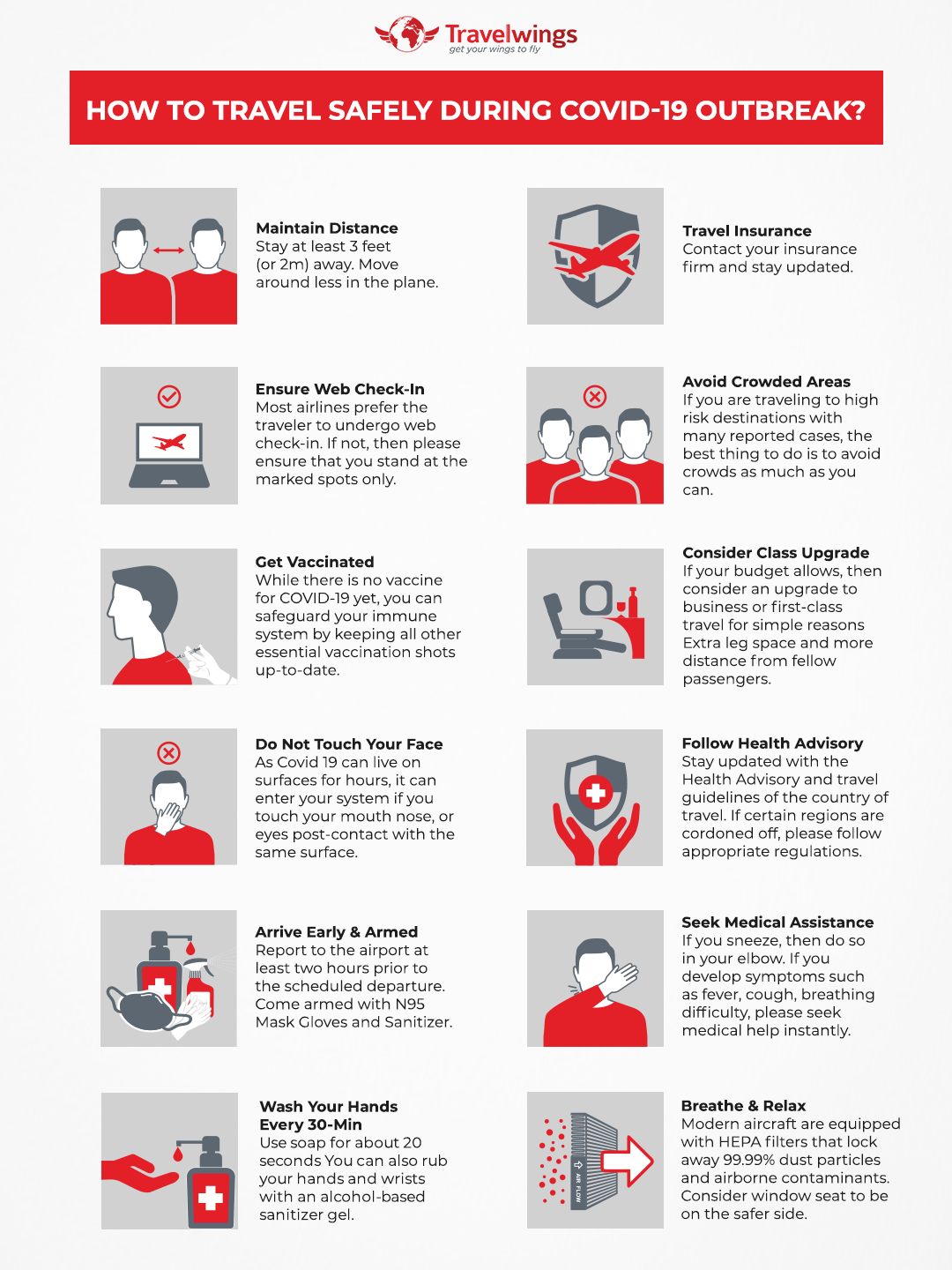

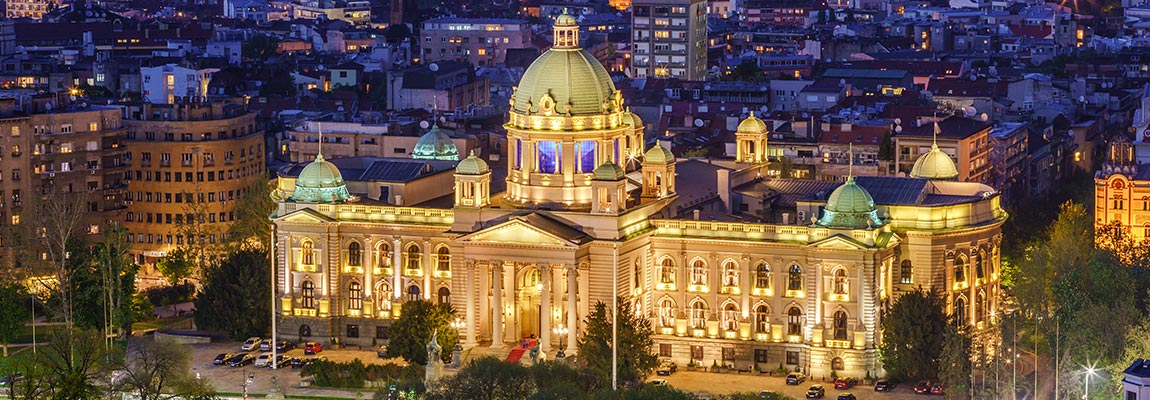
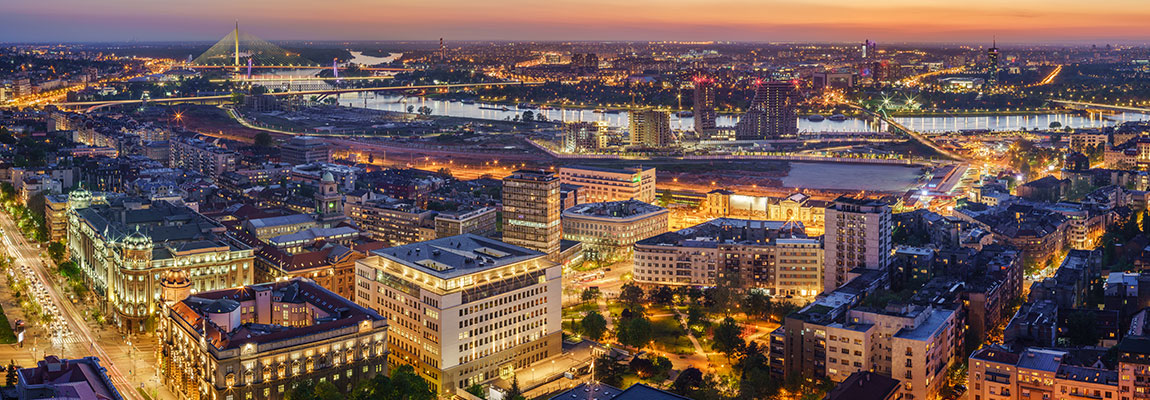
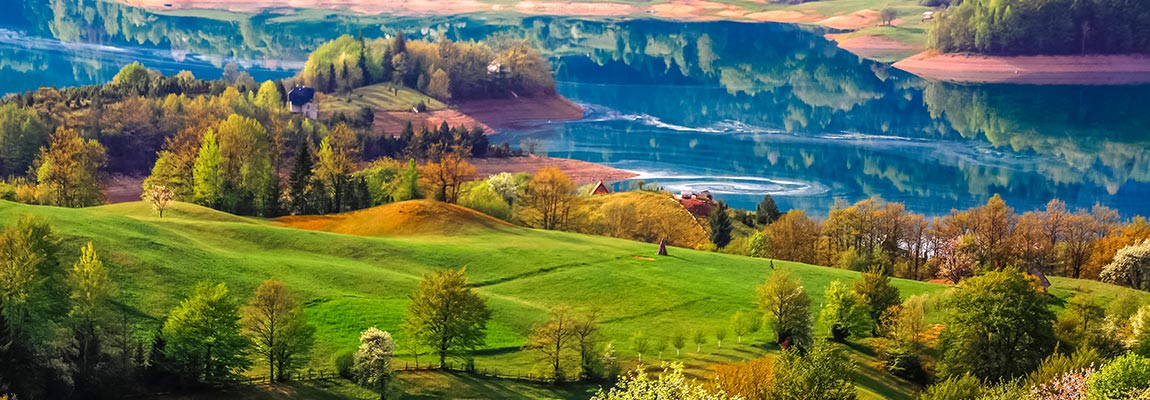
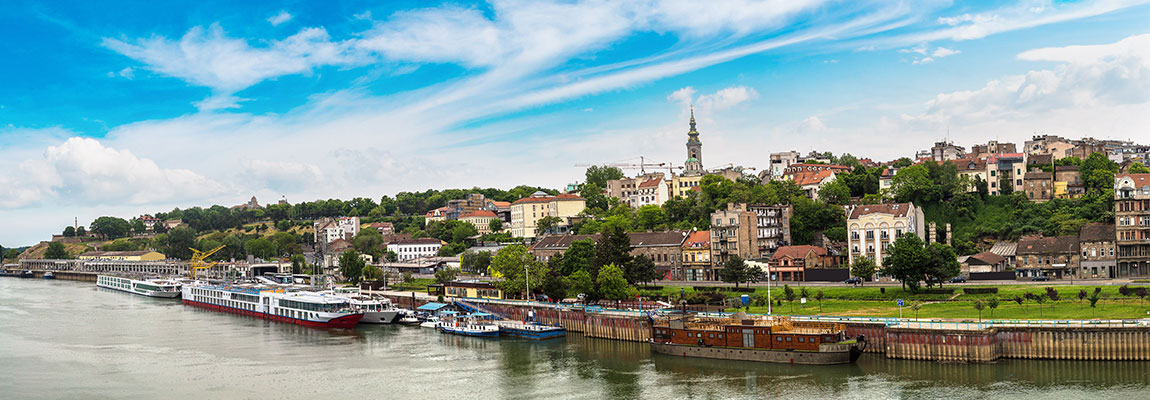
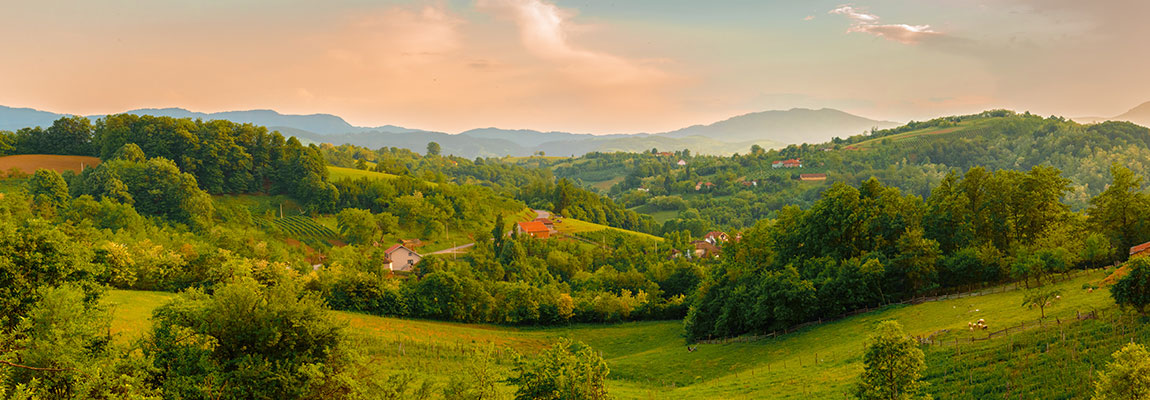
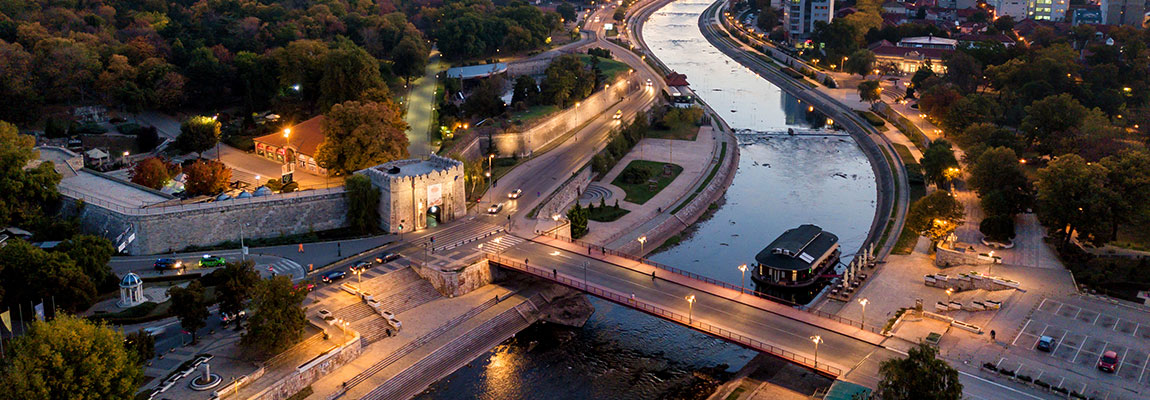
Serbia or also known by its official term 'The Republic of Serbia' is a Balkan country located at the intersection of Central and Southeastern Europe. The country may not be an outspoken destination among travellers, but this allows the country to retain its natural beauty. Serbia was once a part of the Slavic nation but later became a sovereign state. The capital city of Belgrade is at the intersection of the Danube and Sava River. Belgrade tourism is a living example of medieval architecture and also home to some of Europe's most well-renowned Serbian restaurants and cafes.
Famous For: Pirot Kilim (carpet) | Rakija (Serbian brandy) | Paprika | Nikola Tesla | Novak Djokovic | Slava festival | Exit festival | Serbian cuisine | Splavs (floating bars) | Kafana (Serbian traditional bars
Time Zone: UTC+1 (CET)
Driving Side: Right
Airports in Serbia: Belgrade Nikola Tesla Airport | Nis Constantine the Great Airport | Morava Airport
Network ConnectivityNetwork connectivity in Serbia is of excellent quality. More than 85% of households in Serbia have fixed telephone lines. And with more than 9.5 million mobile subscriptions the entire country seems to be connected to the world. Hotels, cafes, restaurants and boutiques offer wifi facilities for in-house and walk-in guests. Internet connection speed in Serbia reaches well over 60 Mbps. Whereas for mobile users it is over 40 Mbps.
The major mobile network operators in Serbia are Telekom Srbija, Telenor and A1 Srbija. Also, Telekom Srbija is the largest of them all with close to 4.3 million subscribers. And supports tourism in Serbia, by providing SIM cards and special offers to tourists.

In the Middle Ages, modern-day Serbia was the birthplace of several roman emperors like Constantine the great. It was also around this time the Christianisation of Serbia had begun. It was also Constantine’s order of allowing religious tolerance across the empire. In 395, post the breakup of the Roman empire, modern-day Serbia was still under the control of the Eastern Roman Empire.
At the beginning of the 10th century, Serbia witnessed the arrival of White Serbs, an early Slavic tribe. The tribe took refuge in an area between the Sava River and the Dinaric Alps. Also, by the same time, most of Serbia had taken Christianity as their religion. During the 10th and the late 12th-century modern-day Serbia went to war with the Byzantine Empire on numerous occasions.
Post the late 12th century the once sturdy Serbian empire broke away into fragments. And also had to face the ottomans advancing from the west, whilst keeping Byzantine at bay. Finally, in 1459 the Ottomans took over Serbia and initiated a cleansing of the Serbian nobility. The remaining were made to serve the Ottoman rulers. This was the reason behind the migrating Serbs, to the western and northern parts of Europe.
The Serbian revolution against the Ottoman rule went on for 11 years, between 1804 - 1815. During this time, the Serbians could invoke 2 uprisings with the second uprising helping them gain independence. 15th February 1835 marked the day of Serbian adopting the First Serbian constitution and the anniversary of their first uprising. Also, this made Serbia the first country in Europe to adopt a constitution.
Located in the Balkan Peninsula and the Pannonian plains, Serbia is a landlocked country at the intersection of Central and southern Europe. Serbia is bordered by Hungary to the North, Romania to the northeast, Bulgaria to the southeast, North Macedonia to the south. And Croatia, Bosnia and Herzegovina to the west and Montenegro to the Southwest. If the territory of Kosovo is to be included, it would also border Albania.
One-third of the northern country is taken by the Pannonian plains, whilst the easternmost tip of the country spreads into the Wallachian Plains. The central part of the country comprises hills and rivers. Mountainous terrain makes up for the remaining third of the southern part of the country. Also, to the southwest, we have the Dinaric Alps that extend up to the west of the country.
Serbian tradition is long-lasting and one with resilience, a lot of the impact on the culture also took its essence from the Ottoman and the Habsburg Empire. The influence to this day is visible in the family and government styled structures across the country. The Byzantine empire also had its influence on the country, primarily through the introduction of Eastern Christianity during the Middle Ages.
Serbian monasteries are the major reminiscence of Serbian medieval architecture. After the fall of Constantinople in 1204, several of the artists from the Byzantine empire fled to Serbia. The Serbian countryside is a great example of traditional Serbian culture and hospitality. The countryside of Serbia still has people who are promoting the Serbian tradition with the help of the arts.
Many historians often travel to the countryside of Serbia to gather information by hearing stories of vampires and ghosts. These stories over the years have been kept alive through memorisation of these tales in the form of long poems. The ‘Guslars’ or storytellers have a recollection of these stories via memorisation of the knowledge from the ancestors. Stevan StojanoviÄ Mokranjac is held in high regard as the founder of modern Serbian music.
Food and DrinkThe staple diet in Serbia generally consists of bread, meat, fruits, vegetables, fish and dairy products. Serbian food plays a crucial role in all religious and festive gatherings. With bread being the most important staple of Serbia culture as it is made use of during religious gatherings and for welcoming guests. The local tradition sees bread and salt being offered to guests as a token of hospitality. Thus, helping promote Serbian culture and Serbia tourism.
The Serbian restaurants and cuisine are majorly influenced by Turkey and Greece, because of the influence from the former ancestral empires. Namely the Ottoman and the Habsburg. In addition, winemaking dates back in Serbia to Roman rule. There are 22 distinct wine-producing regions in Serbia, with white wine being the most produced wine of them all. Also, Serbians claim the country to be the birthplace of “Rakia” (Rakija) which is a strong alcoholic distilled fruit drink.
Must-Try Serbian DishesCevapcici (caseless minced meat sausages), Pljeskavica (grilled spiced meat galette), Sarma (stuffed grape leaves roll), Kajmak ( Serbian clotted cream), Gibanica (puff pastry with cheese and eggs), Ajvar (roasted red pepper spread), Proja (Serbian cornbread), Kacamak ( corn flour porridge), Borek (puff pastry stuffed with cheese or meat)
Must-Try National DrinksCoffee (Turkey style), Rakija (distilled fruit spirit), Slivovitz (Serbian plum brandy), Serbian White wine, Jelen and Lav (Serbian local brewed lager beer brand), Kvass (dark lager)
HospitalitySerbian culture is the perfect example of Ottoman and Byzantine hospitality merged in one. It is one of the most well-renowned things to experience when visiting the country. The people of Serbia are extremely hospitable and if they offer to share their Rakija with you, be ready to be invited over to their house. As a guest to a Serbian household there would be basic things that you would need to keep in mind:
The climate in Serbia is a warm-humid continental or humid subtropical climate. Because of which January’s in the north can register a temperature of 0â leading to cold winters and hot humid summers. The central and the southern parts also remain close to these average temperatures. In summers the average temperature across Serbia is between 17°C - 23°C depending on the altitude. Rainfall patterns are also spread across the seasons with snowfalls during winters.
The best time to visit Serbia if one wishes to beat the heat would be the months from March to August. And if you fancy the cold winter months, then a trip from September to March would seem like the appropriate time. Serbia’s diverse temperatures directly influence the beauty and the lush green valleys of the country. Even the winter months are apt for enjoying winter sports and other activities related to the season. Thus, making Serbia tourism perfect for all seasons.
One of Serbia top tourist attractions, this archaeological marvel was built on the spot where the Ottoman vizier Sinan Pasha burned the relics of St. Sava in response to the Serbian uprising of 1594. It is one of the largest orthodox churches in the Balkan region and the second largest in the world promoting Serbia tourism. The most spectacular feature of the church is the use of white granite and marble, which makes it visible from all the corners of the city.
Best Time to Visit: March to May / September to October
Entry Price: Free
This street is similar to the Dubai City Walk, the largest creative lifestyle space in Belgrade and Serbia. The street features some world-famous high-class fashion brands to some of the expensive restaurant chains and cafes in Europe and the world. The per square feet area of the street is the most expensive in the city of Belgrade resulting in popularising Belgrade tourism. The street extends from the capital's fortress to the Republic Square of the city making it a perfect spot for Serbia tourism.
Best Time to Visit: March to May / September to October
Entry Price: Free
No, this is not one of the mythical Grayskull fortresses from the animated series of He-Man. This tower was a horrifying reminder of the number of lives lost during the first Serbian uprising. The wall is a reminder of how 952 brave Serbian souls, who instead of becoming prisoners of the Ottoman's. Blew up a magazine of gunpowder to avoid capture by the invading forces.
Best Time to Visit: March to May / September to October
Entry Price: $ 1.5
One of the few national parks to have almost 4 gorges and also home to one of the deepest rivers in the world. These gorges merge as one to form the 'Iron Gate' as it is the southern entrance to the Carpathian Mountains. The Park is home to some of the most spectacular flora and fauna that are found in the region. Also, it is home to a lake formed by the hydroelectricity project built on the Danube River.
Best Time to Visit: March to May / September to October
Entry Price: $ 250 for a group of 10 and $ 150 for a group of more than 10
The bustling capital of Serbia is a place to witness everything unique about the country. The city offers a deep dive into history and a revival of the classical heritage buildings being revived into a new centre for the Serbians and tourists alike. The Knez Mihailova street is a perfect blend of heritage, finesse and style clubbed into one. Belgrade also offers some of the best places to try out Burek (national breakfast dish of Serbia).
Visit For: Belgrade Fortress, Skadarlija, Church of St. Sava, Knez Mihailova street, Nikola Tesla Museum, Republic Square, Zemunski kej, Belgrade Military Museum, National Theatre, Museum of Aviation, House of National Assembly of Serbia
ZemunUntil 1918, this city in the suburbs of Serbia was part of the Hungarian rule. However, the essence of Hungarian architecture can still be seen in many of the structures in the city. The city of Zemun is one of the must-visit cities of Serbia, especially their morning food market in Masarikov Trg. Post breakfast a stroll to the top of Gardos Tower is the most beautiful scene of Belgrade, Danube and Zemun all cropped in one.
Visit For: Gardo’s Tower, Masarikov Trg market, Kej OsloboÄenja, Supermarket Talas, Great War Island, Zemun beach
Novi SadOften referred to as the “Serbian Athens”, owing to its long history and once a centre of cultural learning and study. The essence of its history still prevails in its neoclassical architectural buildings found around the city. Freedom Square is one of the major hubs at the heart of the city, where an ancient Renaissance built City Hall and a catholic church bask in the richness of the country’s culture. Also making the location perfect for a peaceful and tranquil stroll.
Visit For: Freedom Square, Danube beach, Dunavski Park, City Museum, Cafe Veliki
Other Popular Cities to Visit in SerbiaThe festival first took place in 2000 as a movement by students upholding peace and democracy in Serbia and the Balkan region. The event takes place every year in the Petrovaradin fortress of the city known as Novi Sad. The festival goes on for days with artists flocking from all over the world just to be able to perform in the festival. The event emphasizes the life of youth through fun and music.
Location: Novi Sad, Serbia
Date: Mostly 1st to 2nd week of July
Since its inclusion in 2003, the Belgrade beer festival has transformed into a crowd gathering event. Every year the festival attracts over half a million people to celebrate some of the best beers in Europe and the Balkan region. Whilst gathering popularity the festival has also won many accolades over the years leading to its growing popularity. The entrance to the entrance and the concert is free and people can sample and buy over 90 different beers.
Location: Belgrade, Serbia
Date: August
Since 1971, FEST has been one of the most important film festivals to have taken place in Belgrade. The cinematic celebration spans over 10 days and screens over 110 movies carefully selected over these days. It has become a common ground for storytellers and artists from across the globe. And has become a common platform for bringing people together with the help of art.
Location: Belgrade, Serbia
Date: July
Other festivals/events celebrated in Serbia
All travellers must have a valid passport to clear the immigration at the airport on arrival. The passport needs to be valid for six months beyond the date of return except for US passport holders. The passport must have at least three blank pages for the entry and exit stamp.
Serbia Visa-On-Arrival/eVisa/ Visa-Free EntrySerbia visa requirements do not require one to apply for a visa for entering Serbia. Anyone entering Serbia may enter without a visa for up to 30 days and US citizens up to 90 days. In case of any extensions, a visa can be applied for from any of the parent country embassies. Check the list for countries with a 30 days visa-free entry:
The country of Serbia has a network of airports that connects the country for local domestic travel. Air Serbia is the only airline in Serbia that operates domestic flights and connects to some of the lesser-known airports in the country.
RoadThe major chunk of traffic that moves around in Serbia is via roads and is done by coaches or buses. In 2018, road transport in Serbia was responsible for commuting nearly 55 million passengers across the country.
RailRail transport in Serbia is mostly used to transport cargo across the country. Rail networks are available for the general public but are not used much to commute within the country. Serbia has rail networks established with all neighbouring countries except Albania.
WaterThe water transport in Serbia is the inland water transport network developed for transporting cargo in Serbia. One might see a few private boats in the rivers, but nothing on a public scale.
Several renowned and popular flights fly from the UAE to various parts of Serbia. Some of the most popular ones are:
The sea route to the port of Belgrade has two of the following options:
The distance of travel via road from Dubai to Belgrade is 4839 Km. The route will take you through countries like Saudi Arabia, Iraq, Syria, Turkey and Bulgaria.
No dress code is needed in general, just be mindful of the religious places and restaurants that require a dress code for entry.
WHAT TO PACK?The country is all about tranquillity and mesmerizing picturesque landscapes. The city of Budapest will cater to all your senses and rejuvenate you for a refreshing start. Budapest is known as a great travel destination and is also lighter on the pocket. Once in the city of Budapest, one should not miss out on the chance to take a dip in the natural hot spring baths to help relax one's mind and body.
Romania (105 km)The country is probably one of the most biogeographically diverse countries in the world. The country prides itself on landscapes ranging from snow-clad mountains to sandy black sea beaches. The country is covered with lush hills of forests and vineyards that visit a truly mesmerizing experience. Romania also has Europe's largest and well-preserved delta to date.
Bulgaria (159 km)The country is one of the oldest countries in Europe, which is visible in its rich cultural and ancestral history. Bulgaria came to be known in 681 AD, and since then has stuck to the first name given to it by Khan Asparuh. Apart from this Bulgaria is also known for its diverse natural landscapes that add to the beauty of the country. From mountains to beaches and from lakes to hot springs, the country has it all.
North Macedonia (201 km)North Macedonia soaks deep in ancient culture, rituals and traditions which to this date emanates from the old architectural buildings spread across the city. The country is blessed with mountain ranges and some of the oldest and deepest lakes in Europe, which makes it a marvel of nature. The cuisine in North Macedonia is an amalgamation of the rich cultures that came together and became one in the beautiful country.
Croatia (115 Km)Croatia is a country that over the years has gained massive popularity and become a popular tourist destination. The country of Croatia is one with beautiful beaches, some of which are crowded and some of which provide a more secluded recluse into peace and tranquillity. The country offers several hidden bays and beaches that are open for a visit away from the prying eyes of regular tourists.
CALLING CODE: +381
Fire brigade: 193
Ambulance: 194
Police: 192
Serbia's currency is the Serbian Dinar and the currency code is RSD. 1 Serbian Dinar is further subdivided into 100 paras.